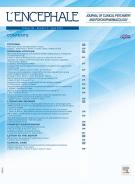L’évaluation sensori-psychomotrice dans l’autisme : un nouvel outil d’aide au diagnostic fonctionnel - 27/03/19
Sensory-psychomotor evaluation in Autism: A new tool for functional diagnosis
 , A. Vachaud a, N. Defas a, J. Malvy a, b, S. Roux b, F. Bonnet-Brilhault a, b
, A. Vachaud a, N. Defas a, J. Malvy a, b, S. Roux b, F. Bonnet-Brilhault a, bCet article a été publié dans un numéro de la revue, cliquez ici pour y accéder
Résumé |
Les troubles sensori-psychomoteurs font partie des signes cliniques nécessaires au diagnostic de trouble du spectre de l’autisme. Ils viennent impacter très précocement les fonctions perceptives et cognitives qui permettent la mise en place d’une communication sociale harmonieuse. Le manque d’outil clinique dans ce domaine a nécessité la création d’une nouvelle échelle : l’Échelle des Particularités Sensori-psychomotrices dans l’Autisme (EPSA). L’EPSA a pour objectif de mesurer l’intensité des atypies sensori-psychomotrices et ainsi d’objectiver des profils singuliers. L’EPSA se compose de 160 items regroupés en 20 variables : toucher, nociception, sensibilité vestibulaire, proprioception, vision, audition, multimodalité, tonus, posture, équilibre, coordination globale, motricité manuelle, schéma corporel, conscience psychocorporelle, ajustement à l’autre, expression émotionnelle, utilisation des objets, espace, temps, régulation tonico-émotionnelle. Dans une large population de 111 enfants avec TSA, l’analyse factorielle a permis d’extraire trois facteurs principaux pertinents au niveau clinique et scientifique, intitulés : « synchronisation sensori-émotionnelle », « intégration multimodale », « compétences motrices ». De plus, cette échelle présente une excellente fidélité inter-cotateurs, une bonne validité interne et externe. L’EPSA est un nouvel outil clinique, présentant de bonnes qualités psychométriques, au service du psychomotricien. Elle rend lisibles les particularités sensori-psychomotrices dans l’autisme, et ouvre ainsi de nouvelles perspectives tant pour préciser le projet thérapeutique individualisé que pour élaborer de nouvelles hypothèses de recherche.
Le texte complet de cet article est disponible en PDF.Abstract |
Introduction |
Psychomotor impairments in Autism Spectrum Disorders (ASD) have frequently been described in scientific literature. Such deficits impact upon the development of social motor function and interfere with the ability to adjust to everyday life. The inclusion of sensory-motor signs in the Diagnostic and Statistical Manual of Mental Disorders (DSM-5) confirms their importance in the diagnosis of ASD. Previous literature has shown the presence precocity of these signs, sometimes before the alteration of the social communication. To our knowledge, there are no existing clinical tools to measure sensory-psychomotor deficit, specifically in ASD. The current paper presents the construction and validation of a new scale, designed to evaluate sensory-psychomotor signs in Autism: ‘the Sensory-psychomotor Particularities Scale in Autism’ (SPSA).
Method |
The scale is composed of 160 items describing common sensory-psychomotor signs in autism. These items are grouped into 20 variables: touch, nociception, vestibular sensitivity, proprioceptive sensitivity, vision, auditory, multimodality, tone, posture, balance, global coordination, manual dexterity, body schema, bodily self-consciousness, relational adjustment, emotional expression, use of objects, space, time and tonico-emotional regulation. For each item, the psychomotor therapist evaluated sensori-psychomotor signs according to a five-level Likert scale (0=“the sign is never expressed by the person”, 1=“weakly expressed”, 2=“moderately expressed”, 3=“severely expressed” and 4=“the sign is very characteristic of the person and very severely expressed”). This is completed by a family interview in order to assess the impact of these signs on everyday situations. The study included 111 children with autism. The presence of neurological and genetic diseases was exclusion criteria. For each child, a global developmental evaluation was carried out by an expert clinical team specializing in ASD. Standardized clinical tools were used: Autism Diagnostic Observation Schedule (ADOS), Childhood Autism Rating Scale (CARS), Behavior Summarized Evaluation scale (BSE-R), Repeated and Restricted Behavior scale (RRB), Movement Assessment Battery for Children (M-ABC), Motor Development Rating scale (MDR), Sensory Profile (SP). Developmental quotients (DQ) were evaluated using various tests depending on age and ability.
Results |
Factor analysis produced three clinically relevant factors: F1: “sensory-emotional synchronization”, F2: “multisensory integration” and F3: “motor skills”: each containing a similar quantity of items. They account for roughly equal percentages of variance (18.9%, 18.0%, 16.8%, respectively). The factorial structure does not change if the 26 children with comorbid developmental coordination disorder are removed. The three factors show good internal consistency and excellent inter-rater reliability. F1 is comprised of 6 items: touch, nociception, proprioceptive sensitivity, vision, emotional expression and tonico-emotional regulation. This factor is significantly associated with items of the Sensory Profile (touch processing, poor registration, sensory seeking). F2 is comprised of 5 items: multimodality, bodily self-consciousness, relational adjustment, use of objects and space. This factor is associated with ADOS, BSE-R and RRB scores, and the item “touch processing” of the Sensory Profile. F3 is comprised of 4 items: tone, posture, global coordination, manual dexterity. This factor is associated with the M-ABC, the MDR and the item “low endurance” of the Sensory Profile.
Conclusion |
The SPSA is a relevant clinical tool to assess the severity of sensory-psychomotor clinical signs in order to describe the individual profiles of children with ASD. It represents a critical step in advancing knowledge of the complex and heterogeneous pattern of psychomotor development in autism. It could make a valuable contribution to the field, both in research and clinical practice.
Le texte complet de cet article est disponible en PDF.Mots clés : Trouble du spectre de l’autisme, Échelle, Particularités sensori-psychomotrices
Keywords : Autism spectrum disorder, Scale, Sensory-motor signs, Psychomotor disorders
Plan
Bienvenue sur EM-consulte, la référence des professionnels de santé.
L’accès au texte intégral de cet article nécessite un abonnement.
Déjà abonné à cette revue ?

